Land and Natural Resources
Métis worldview reflects an ecological perspective that advocates careful use of renewable and non-renewable resources. Sustainability means finding a balance between environmental and economic needs.
Minister of Land and Environment – Michelle LeClair
The Department of Lands and Resources promotes and protects Métis interests regarding environmental issues. It ensures a flow of information between the provincial and federal governments, industry, and Métis Nation-Saskatchewan citizens.
- We provide support and advice on issues regarding Duty to Consult, Harvesting, and environmental issues facing today’s Métis.
- We strive to include Métis participation in consultation and decisions affecting the Locals, Regions and the Province.
- We promote relationships with the Crown regarding Métis harvesting rights.
- We contribute to stakeholder committees to ensure a Métis perspective.
Committees that Lands and Resources have been invited to participate in:
Woodland Caribou Recovery Strategy
Environment Canada: Species at Risk
Sturgeon River Plains Bison Management Committee
HARVESTING


Throughout the history of the Métis Nation, our people have relied on the bounty offered by Mother Earth.
Minister: Glen McCallum
As our Nation evolved throughout the great expanse called Canada, our citizens hunted, fished, and gathered plants to ensure the survival of our families.
As John Palliser remarked in 1857, “this pemmican harvest of their buffalo hunts was brought in for trade by the Indians of the Plains and the Half Breeds of Red River who organized with military discipline under their leader, the warden of the Plains, who went out on the Prairies every year on two tremendous buffalo hunts.”
The 1924 testimony of Elder Patrice Fluery noted that the location of present day Saskatoon was a primary buffalo hunting ground called “Bois de Fleche.”
As in the past, harvesting from Mother Earth remains an integral tradition of our Nation that we inherited from our ancestors. In the North, the people of the two oldest Métis communities, Île-à-la-Crosse and Cumberland House, continue to this day to provide sustenance for their families by hunting, fishing and gathering wild rice, berries and using traditional medicinal plants.
Over the past four years, Métis Nation-Saskatchewan has embarked on an ambitious process of discussions with the Government of Saskatchewan over the issue of harvesting. We are working with many institutions, groups, and the federal and provincial governments to ensure that our tradition of harvesting will continue and be practiced by future generations of Métis citizens.
Harvesting Memorandum of Understanding
In November 2010, MN-S and the Province of Saskatchewan signed a Memorandum of Understanding (MOU) on Métis harvesting rights. The MOU addresses the negotiation of several key actions needed for an interim and ultimately final agreement between the parties on issues regarding:
- Métis community and Métis traditional territories;
- Métis food harvesting customs, practices and traditions;
- Ancestral and community acceptance requirements necessary to be a beneficiary of harvesting rights;
- Achieving legal enforceability and certainty of those rights; and,
- The identification of additional research or studies necessary to assist MN-S and the Province of Saskatchewan to reach interim and final agreements.
Métis Parameters Currently Guiding Métis Harvesting for Food in Saskatchewan
The rights of Métis harvesters are determined by four legal decisions: the Supreme Court of Canada decision, R. v. Powley (2003), and three provincial decisions, R. v. Morin & Daigneault (1966), R. v. Laviolette (2005), and R. v. Belhumeur (2007).
R. v. Powley confirmed, through section 35 of the Constitution Act, 1982, the Métis right to harvest, while emphasizing the need to develop a more systematic method of identifying people of Métis ancestry. The MN-S response to this was the development of a secure and objectively verifiable citizenship card which proves Métis ancestry and ancestral connections to the Métis homeland. It is NOT a provincial Métis harvesting card.
Powley set out the criteria for determining who can exercise that right:
- You must self-identify as Métis;
- You must be ancestrally connected to an historic Métis community;
- You must be accepted as a member of a modern Métis community that has evolved from an historic Métis community.
In 1996, with the R. v. Morin & Daigneault decision, the Métis of North-West Saskatchewan (those living north of the Northern Administrative District boundary) had their constitutional right to harvest for food recognized.
The release of the R. v. Laviolette decision also recognized a rights-bearing Métis community throughout North-West Saskatchewan (East from Lac la Biche to Île-à-la-Crosse, south to Green Lake, southwest to Meadow Lake, and northwest to Lac la Biche) and members of that rights-bearing Métis community can harvest throughout their traditional territory.
Despite the R. v. Belhumeur decision, in which Donald Belhumeur of Regina was found not guilty of fishing without a licence in the Qu’Appelle Valley, the Saskatchewan Ministry of Environment has maintained the approach that Métis food rights are unclear. This means that Métis harvesting cases will be assessed on a case-by-case basis, i.e. Métis harvesters in the southern region of the province may be charged if caught.
In summary, harvesters must be aware that:
- They can only harvest in areas where a harvesting court case has been won;
- They must satisfy the criteria set out in R v. Powley;
- In all other areas of the province, Métis assertions of these rights are considered on a case-by-case basis, and are subject to investigation and possible prosecution.
If you decide to harvest for food, MN-S recommends that you:
- Obtain a provincial Métis citizenship card for identification purposes should you be approached by a Conservation Officer;
- Ensure that you have written and verbal permission to hunt on any private or First Nations lands;
- Follow safety and conservation laws while harvesting.
DUTY TO CONSULT
What is Duty to Consult and Accommodate?
Duty to Consult and Accommodate (DTCA) arose out of the Supreme Court of Canada’s judgments in the Haida Nation case, as well as the Taku River Tlingit First Nation and Mikisew Cree First Nation cases, which opened up new possibilities for relationships between governments and Aboriginal communities. This duty requires governments to consult First Nations, Inuit and Métis peoples and accommodate their interests whenever a Crown considers conduct that might adversely affect Aboriginal rights or interests.
Who is responsible for DTCA?
The legal framework determines that the duty flows from the honour of the Crown and s.35 of the Constitution Act, 1982. The duty applies when the Crown has real or constructive knowledge of the potential existence of Aboriginal rights or title that may be at risk from a course of action being contemplated by a Crown. The duty demands that all governments work with Aboriginal peoples to understand their interests and concerns prior to authorizing or proceeding with a plan, policy, development or activity that has the potential to affect Aboriginal rights.
What is the purpose of DTCA?
The purpose of the duty is achieved when government addresses, modifies or reconciles its actions with Aboriginal interests in a real and substantive way. It is designed to promote the transformation of the existing relationship between the Crown and First Nations, Inuit and Métis peoples to a new relationship based on consultation, accommodation, just settlements and reconciliation.
What triggers a DTCA?
DTCA may be triggered by Government decisions and actions that have the potential to adversely impact the exercise of Treaty and Aboriginal rights and pursuit of tradi-tional uses. The decisions and actions that will be assessed by governments for potential consultation obligations include, but are not limited to the following:
- Legislation, regulation, policy and strategic plans
- Fish and wildlife management
- Resource extraction
- Land reservations
- Land use planning
- Lease, grant or sale of unoccupied crown land
- Changes to public access
- Environmental approvals
What are Métis Nation-Saskatchewan principles concerning engagement, consultation, and accommodation?
- The fulfillment of the duty requires good faith on the part of all parties and consultations must be conducted in equitable, transparent and respectful manner.
- Timelines must be reasonable and provide sufficient opportunity for the Métis to review and assess the information provided by the Crown or industry.
- The Crown must recognize and support the unique capacity needs and realities of the Métis people and their elected governance structures at the local, regional and provincial levels.
- The Crown must provide the necessary funding/capacity to Métis government or ensure the necessary funding/capacity is provided to Métis government to engage with government and/or industry, as well as with Métis citizens.
- Consultations must be with the Métis government structures that are elected and supported by the Métis people. Consultations with individual Métis, service delivery organizations, mayors and municipal councils, and pan-Aboriginal structures cannot discharge the duty owed to the Métis, as a rights–bearing people.
- Métis government has the responsibility to consult with its citizens and represent its citizens, not the Crown or industry.
- Métis consultation processes must provide all Métis citizens the opportunity to participate and be heard (i.e. public meetings, |timely information, etc.)
- Ultimate decision-making with respect to consultation and accommodation must rest with the affected rights-bearing Métis community.
Links to:
Métis Nation Climate Change Strategy
The Métis National Council (MNC) has released the first-ever Métis Nation Climate Change Strategy, created in collaboration with Governing Members, LFMO, and the National Youth Council. Members of the Métis Nation–Saskatchewan Lands & Environment team were proud to contribute to the strategy, which provides a roadmap to Métis-driven solutions to climate change through environmental stewardship and leadership.
Read full the Métis Nation Climate Change Strategy now: Métis Nation Climate Change Strategy
Visit the MNC webpage for more details: https://www.metisnation.ca/what-we-do/environment/climate-change
Métis Guardians Program
Join the Métis Guardians Monitoring Network Today
The Métis Nation–Saskatchewan Ministry of Lands and Environment is proud to reopen the application process that allows you to become a guardian of our environment!
As a Métis Guardian Monitor with the Métis Guardians Monitoring Network, you’ll play an active, meaningful role in environmental monitoring across the province, with a focus on climate change, emergency response, and culture. The Métis Guardians Monitoring Network involves both western science and traditional knowledge to form a braided system of environmental protection.
